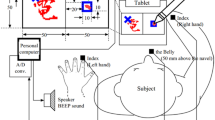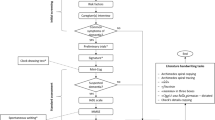Abstract
Background and aims: Despite the importance of handwriting in everyday life, virtually no literature can be found documenting the extent and range of everyday handwriting performance and ability among healthy elderly persons. The aim of this pilot study was to examine the kinematic characteristics of the handwriting process of healthy elderly persons and its correlates. Methods: Fifty-three healthy participants (aged 60 to 94) living in the community, performed five functional writing tasks using a computerized system which documented the handwriting process. Results: In air time (i.e., the time of non-writing while writing) accounted for approximately half to two-thirds of total writing time. Higher age was consistently associated with longer on paper and in air time, as well as with lower speed and lower pressure. Conclusions: The results of this pilot study indicate that kinematic analysis of handwriting provides important information about the handwriting process among elderly people.
Similar content being viewed by others
References
U.S. Census Bureau. International database. Table 094. Midyear population, by age and sex. Available at: http://www.census.gov/ population/www/projectiond/nardet-D1A.html.
Hackel ME, Wolfe GA, Bang SM, Canfield JS. Changes in hand function in aging adults as determined by the Jebsen test of hand function. Phys Ther 1992; 72: 373–7.
Backman C, Mackie H, Harris J. Arthritis Hand Function Test: Development of a standardized assessment tool. Toronto: Canadian association of occupational therapists publication. 1990.
Carmeli E. Patish H. Colman R. The aging hand. J Gerontol A Biol Sci Med Sci 2003; 58: 146–52.
Shiffman LM. Effects of aging on adult hand function. Am J Occup Ther 1992; 46: 785–92.
Carmeli, D, Reed T. Stability and change in genetic and environmental influences on hand-grip strength in older male twins. J Appl Physiol 2000; 89: 1879–83.
Ranganathan VK, Siemionow V, Sahgal V, Liu JZ, Yue GH. Skilled finger movement exercise improves hand function. J Gerontol 2001; 56: M518–22.
Cole KJ, Rotella DL, Harper JG. Mechanisms for age-related changes of fingertip forces during precision gripping and lifting in adults. J Neurosci 1999; 19: 3228–47.
Grimby G, Danneskiold-Samsoe B, Hvid K, Saltin B. Morphology and enzymatic capacity in arm and leg muscles in 78–81 year old men and women. Acta Physiol Scand 1982; 115: 125–34.
Jette AM, Branch LG, Berlin J. Musculoskeletal impairments and physical disablement among the aged. J Gerontol 1990; 45: M203–8.
Kinoshita H, Francis PR. A comparison of prehention force control in young and elderly individuals. Eur J Appl Physiol Occup Physiol 1996; 47: 450–60.
Cerella J. Pigeon pattern perception: limits on perspective invariance. Perception 1990; 19: 141–59.
Salthouse TA. The role of processing resources in cognitive aging. In Howe ML, Brainerd CJ, Eds. Cognitive development in Adulthood: Progress in Cognitive Development Research. New York: Springer-Verlag. 1988: 185–239.
Jones N, Adams J. An overview of the effect of ageing on hand function Int J Therapy Rehab 2003; 10: 374–77.
Dixon RA, Kurzman D, Friesen IC. Handwriting performance in younger and older adults: age, familiarity, and practice effects. Psychol Aging 1993; 8: 360–70.
Reisman J. Using a sensory integrative approach to treat self injurious behavior in an adult with profound mental retardation. Am J Occup Ther 1993; 47: 403–11.
Tseng MH, Cermak, SA. The influence of ergonomic factors and perceptual-motor abilities on handwriting performance. Am J Occup Ther 1993; 47: 919–26.
Wechsler D. Wechsler Adult Intelligence Scale, 7th ed. New York: Psychological Corporation, 1955.
Contereas-Vidal JL, Teulings HL, Stelmach GE. Elderly subjects are impaired in spatial coordination in fine motor control. Acta Psychol 1998; 100: 25–35.
Werner P, Heinik J, Mendel A. Examining the reliability and validity of the Hebrew version of the Mini Mental State Examination. Aging Clin Exp Res 1999; 11: 329–34.
Tangalos EG, Smith GE, Ivnik RJ et al. The Mini-Mental State Examination in general medical practice: clinical utility and acceptance. Mayo Clinic Proc 1996; 71: 829 - 837.
Srikanth V, Thrift AG, Fryer JL, et al. The validity of brief screening cognitive instruments in the diagnosis of cognitive impairment and dementia after first-ever stroke. Int J Psychogeriatr 2006; 18: 295–305.
Rosenblum S, Parush S, Weiss PL. The in air phenomenon: temporal and spatial correlates of the handwriting process. Percept Mot Skills 2003; 96: 933–54.
Rosenblum S, Parush S, Weiss PL. Computerized temporal handwriting characteristics of proficient and poor handwriters. Am J Occup Ther 2003; 57: 129–38.
Derouesne C, Lacomblez L, Thibault S, LePoncing M. Memory complaints in young and elderly subjects. Int J Geriatr Psychiatry 1999; 14: 291–301.
Werner P, Rosenblum S, Bar-On G, et al. Handwriting process variables discriminating mild Alzheimer’s disease and mild cognitive impairment. J Gerontol B Psychol Sci Soc Sci 2006; 61: 228–36.
Jette AM, Assmann SF, Rooks D, Harris BA, Crawford S. Interrelationships among disablement concepts. J Gerontol A Biol Sci Med Sci 1998; 53: M395–404.
Fried LP, Guralnik JM. Disability in older adults; evidence regarding significance, etiology and risk. J Am Geriatr Soc 1997; 45: 92–100.
Fried LP, Storer DJ, King DE, Lodder F. Diagnosis of illness presentations in the elderly. J Am Geriatr Soc 1991; 39: 117–23.
Gilbertson L, Barber-Lomax S. Power and pinch grip strength recorded using the hand-held JAMAR dynamometer and B+ L hydraulic. Brit J Occupat Therapy 1994; 57: 483–87.
Burton J. The model of human occupation and occupational therapy practice with elderly patients, Part 1: characteristics of aging. Brit J Occupat Therapy 1989; 52: 215–18.
Desrosiers J, Herbert R, Bravo G, Dulit E. Upper-extremity motor co-ordination in healthy elderly people. Age Ageing 1995; 24: 108–12.
Stelmach GE, Goggin NL, Garcia-Colera A. Movement specification time with age. Exp Aging Res 1987; 13: 39–46.
Benbow M. Principles and practices of teaching handwriting. In Henderson A, Pehoski C, eds. Hand function in the child. St. Louis: Mosby, 1995: 255–81.
Aniansson A, Rundgren A, Sperling L. Evaluation of functional capacity in activities of daily living in 70-year-old men and woman. Scand J Rehabil Med 1980; 2: 145–54.
Hyatt RH, Whitlaw MN, Bhat A, Scott S, Maxwell JD. Association of muscle strength with functional status of elderly people. Age Aging 1990; 19: 330–36.
Sperling L. Evaluation of upper extremity function in 70-year-old men and women. Scand J Rehabil Med 1980; 12: 139–144.
Darling WG, Cooke JD, Brown, SH. Control of simple arm movement in elderly humans. Neurobiol Aging 1989; 10: 149–57.
Galganski ME, Fuglevand AJ, Enoka R. Reduced control of motor output in human hand muscle of elderly subjects during sub-maximal contractions. J Neurophysiol 1993; 69: 2108–15.
Kanda K, Hashizume K. Changes in properties of the medial gastrocenemius motor units in rats. J Neurophysiol 1989; 61: 737–46.
Teulings HL, Stelmach GE. Control of stroke size, peak acceleration, and stroke duration in parkinsonian handwriting. Hum Mov Sci 1991; 10: 315–34.
Teulings H, Stelmach GE. Stimulation of impairment of force amplitude and force timing in parkinsonian handwriting. In Stelmach GE, Requin J, Eds. Tutorials in Motor Behavior II. Amsterdam: Elsevier, 1992: 425–42.
Terao S, Sobue G, Hashizume Y. Age related changes in human spinal ventrals horn cells with special reference to the loss of small neurons in the intermediate zone: A quantitative analysis. Acta Neuropathol 1993; 92: 109–14.
Kershalo DR. Somesthetic sensitivity in young and elderly humans. J Gerontol 1986; 41: 732–42.
Fronterna WR, Suh D, Krivickas LS, Hughes VA, Goldstein R, Roubenoff R. Skeletal muscle fiber quality in older men and woman. Am J Physiol 2000; 279: 611–8.
Berninger V, Mizokawa D, Bragg R. Theory-based diagnosis and remediation of writing. J Sch Psychol 1991; 29: 57–9.
Berninger VW, Vaughan KB, Abbott, RD, et al. Treatment of handwriting problems in beginning writers: transfer from handwriting to composition. J Educ Psychol 1997; 89: 652–66.
Lindle RS, Metter EJ, Lynch NA. Age and gender comparisons of muscle strength in 654 woman and men aged 20–93 yr. J Appl Physiol 1997; 83: 1581–7.
Ericsson K, Forssell L, Amberla K, Holmen K, Vitanen M, Winbald B. Graphic skills used as an instrument for detecting higher cortical dysfunctions in old age. Hum Mov Sci 1991; 10: 335–49.
Rosenblum S, Weiss PL, Parush S. Product and process evaluation of handwriting difficulties: A review. Educat Psychol Rev 2003; 15: 41–81.
Author information
Authors and Affiliations
Corresponding author
Rights and permissions
About this article
Cite this article
Rosenblum, S., Werner, P. Assessing the handwriting process in healthy elderly persons using a computerized system. Aging Clin Exp Res 18, 433–439 (2006). https://doi.org/10.1007/BF03324840
Received:
Accepted:
Published:
Issue Date:
DOI: https://doi.org/10.1007/BF03324840




